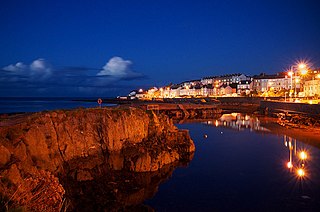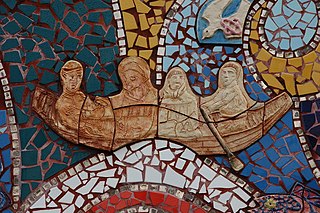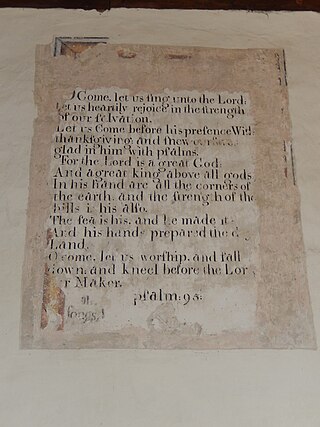| Sancti venite | |
|---|---|
| by monks at Bangor Abbey | |
| English | Come all ye holy |
| Genre | Hymn |
| Written | 7th century |
| Language | Latin |
| Meter | 10.10 |
| Published | AD 680–691 |

"Sancti venite" is a Latin Eucharistic hymn recorded in the Antiphonary of Bangor. [1]
| Sancti venite | |
|---|---|
| by monks at Bangor Abbey | |
| English | Come all ye holy |
| Genre | Hymn |
| Written | 7th century |
| Language | Latin |
| Meter | 10.10 |
| Published | AD 680–691 |

"Sancti venite" is a Latin Eucharistic hymn recorded in the Antiphonary of Bangor. [1]
"Sancti venite" was composed at Bangor Abbey in the 7th century AD, making it the oldest known Eucharistic hymn. [2]
It was carried to Bobbio Abbey and was first published by Ludovico Antonio Muratori in his Anecdota Latina ex Ambrosianæ Bibliothecæ codicibus (1697–98), when he discovered it in the Biblioteca Ambrosiana. [3]
According to a legend recorded in An Leabhar Breac , the hymn was first sung by angels at St. Seachnall's Church, Dunshaughlin, after Secundinus had reconciled with his uncle Saint Patrick. [4]
| Latin text | English text (tr. John Mason Neale, 1851) | |
|---|---|---|
Sancti venite, Christi corpus sumite, | Draw nigh and take the Body of the Lord, |

County Down is one of the six counties of Northern Ireland, one of the nine counties of Ulster and one of the traditional thirty-two counties of Ireland. It covers an area of 961 sq mi (2,490 km2) and has a population of 552,261. It borders County Antrim to the north, the Irish Sea to the east, County Armagh to the west, and County Louth across Carlingford Lough to the southwest.
Adam of Saint Victor was a prolific poet and composer of Latin hymns and sequences. He has been called "...the most illustrious exponent of the revival of liturgical poetry which the twelfth century affords."

Gall according to hagiographic tradition was a disciple and one of the traditional twelve companions of Columbanus on his mission from Ireland to the continent. However, he may have originally come from the border region between Lorraine and Alemannia and only met Columbanus at the monastery of Luxeuil in the Vosges. Gall is known as a representative of the Irish monastic tradition. The Abbey of Saint Gall in the city of Saint Gallen, Switzerland was built upon his original hermitage. Deicolus was the elder brother of Gall.

Bangor is a city and seaside resort in County Down, Northern Ireland, on the southern side of Belfast Lough. It is within the Belfast metropolitan area and is 13 miles (22 km) east of Belfast city centre, to which it is linked by the A2 road and the Belfast–Bangor railway line. The population was 64,596 at the 2021 Census. Bangor was granted city status in 2022, becoming Northern Ireland's sixth city.

Anglican church music is music that is written for Christian worship in Anglican religious services, forming part of the liturgy. It mostly consists of pieces written to be sung by a church choir, which may sing a cappella or accompanied by an organ.

Notker the Stammerer, Notker Balbulus, or simply Notker, was a Benedictine monk at the Abbey of Saint Gall active as a composer, poet and scholar. Described as "a significant figure in the Western Church", Notker made substantial contributions to both the music and literature of his time. He is usually credited with two major works of the Carolingian period: the Liber Hymnorum, which includes an important collection of early musical sequences, and an early biography of Charlemagne, the Gesta Karoli Magni. His other works include a biography of Saint Gall known as the Vita Sancti Galli and a martyrology, among others.

The Liturgy of Saint James is a form of Christian liturgy used by some Eastern Christians of the Byzantine rite and West Syriac Rite. It is developed from an ancient Egyptian form of the Basilean anaphoric family, and is influenced by the traditions of the rite of the Church of Jerusalem, as the Mystagogic Catecheses of Cyril of Jerusalem imply. It became widespread in Church of Antioch from the fourth or fifth century onwards, replacing the older Basilean Liturgy of Antioch. It is still the principal liturgy of the Syriac Orthodox Church, the Malankara Orthodox Syrian Church, the Maronite Church, the Syriac Catholic Church, Syro-Malankara Catholic Church and other churches employing the West Syriac Rite. It is also occasionally used in the Eastern Orthodox Church and Melkite Catholic Church. The Malankara Mar Thoma Syrian Church uses a reformed variant of this liturgy, omitting intercession of saints and prayer for the dead.

Bangor Abbey was established by Saint Comgall in 558 in Bangor, County Down, Northern Ireland and was famous for its learning and austere rule. It is not to be confused with the slightly older abbey in Wales on the site of Bangor Cathedral.

Saint Comgall, an early Irish saint, was the founder and abbot of the great Irish monastery at Bangor in Ireland.

The term "Celtic Rite" is applied to the various liturgical rites used in Celtic Christianity in Britain, Ireland and Brittany and the monasteries founded by St. Columbanus and Saint Catald in France, Germany, Switzerland, and Italy during the early middle ages. The term is not meant to imply homogeneity; instead it is used to describe a diverse range of liturgical practices united by lineage and geography.
The Antiphonary of Bangor is an ancient Latin manuscript, supposed to have been originally written at Bangor Abbey in modern-day Northern Ireland.

An antiphonary or antiphonal is one of the liturgical books intended for use in choro, and originally characterized, as its name implies, by the assignment to it principally of the antiphons used in various parts of the Latin liturgical rites.

Blood of Christ, also known as the Most Precious Blood, in Christian theology refers to the physical blood actually shed by Jesus Christ primarily on the Cross, and the salvation which Christianity teaches was accomplished thereby, or the sacramental blood (wine) present in the Eucharist or Lord's Supper, which some Christian denominations believe to be the same blood of Christ shed on the Cross.

Psalm 95 is the 95th psalm of the Book of Psalms, beginning in English in the King James Version: "O come, let us sing unto the LORD: let us make a joyful noise to the rock of our salvation". The Book of Psalms starts the third section of the Hebrew Bible, and, as such, is a book of the Christian Old Testament. In the slightly different numbering system in the Greek Septuagint version of the Bible, and in the Latin Vulgate, this psalm is Psalm 94. In Latin, it is known as "Venite exultemus" or simply "Venite". The psalm is a hymn psalm, one of the Royal psalms, praising God as the King of His people. Psalm 95 identifies no author, but Hebrews 4:7 attributes it to David. The Vulgate also names David as the author.
"Saint Patrick's Breastplate" is an Old Irish prayer of protection of the "lorica" type attributed to Saint Patrick.
"Adoro te devote" is a prayer written by Thomas Aquinas. Unlike hymns which were composed and set to music for the Solemnity of Corpus Christi, instituted in 1264 by Pope Urban IV for the entire Latin Church of the Catholic Church, it was not written for a liturgical function and appears in no liturgical texts of the period; some scholars believe that it was written by the friar for private use at Mass. The text has since been incorporated into public worship as a hymn.
The Celtic mass is the liturgy of the Christian office of the Mass as it was celebrated within Celtic Rite of Celtic Christianity in the Early Middle Ages.
Reginald of Canterbury was a medieval French writer and Benedictine monk who lived and wrote in England in the very early part of the 12th century. He was the author of a number of Latin poems, including an epic entitled Malchus, which still survives.

St. Seachnall's Church is a medieval church and National Monument in County Meath, Ireland.